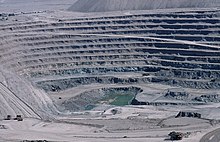Smelting (historical)
The calcine is then mixed with silica and limestone and smelted at 1200 °C (in an exothermic reaction) to form a liquid called copper matte. This temperature allows reactions to proceed rapidly, and allow the matte and slag to melt, so they can be tapped out of the furnace. In copper recycling, this is the point where scrap copper is introduced.
- Several reactions occur.
- For example iron oxides and sulfides are converted to slag which is floated off the matte. The reactions for this are:
- FeO(s) + SiO2 (s) → FeO.SiO2 (l)
- In a parallel reaction the iron sulfide is converted to slag:
- 2FeS(l) + 3O2 + 2SiO2 (l) → 2FeO.SiO2(l) + 2SO2(g)
The slag is discarded or reprocessed to recover any remaining copper.
Production


Most copper ore is mined or extracted as copper sulfides from large open pit mines in porphyry copper deposits that contain 0.4 to 1.0% copper. Examples include: Chuquicamata in Chile, Bingham Canyon Mine in Utah and El Chino Mine in New Mexico, US. The average abundance of copper found within crustal rocks is approximately 68 ppm by mass, and 22 ppm by atoms. In 2005, Chile was the top mine producer of copper with at least one-third world share followed by the USA, Indonesia and Peru, reports the British Geological Survey.[1]
Flash smelting (modern)
Flash smelting (Finnish: Liekkisulatus) is a smelting process for sulfur-containing ores [2] including chalcopyrite. The process was developed by Outokumpu in Finland and first applied at the Harjavalta plant in 1949 for smelting copper ore.[3][4] It has also been adapted for nickel and lead production.[3]
The process uses the autogenic principle by using the energy contained in the sulfur and iron for melting the ore.[5] In the process dried and powdered ore is discharged from a nozzle into a fluidized bed reactor fed with oxygen. The reduced metal melts, and drops to the bottom of a settling chamber. The flotation produces a large effective surface area of fine-grained concentrate particles.[5] The process makes smelting more energy efficient and environmentally friendly.[5] Sulfur is released mainly in its solid form, thus reducing atmospheric pollution.[2] The process is today used for 50% of the world’s primary copper production.[3] The other 50% is mainly produced from oxide ores, where the process cannot be applied.
Outotec, formerly the technology division on Outokumpu now holds Outokumpu's patents to the technology and licenses it worldwide.